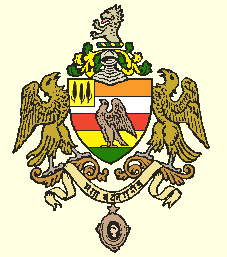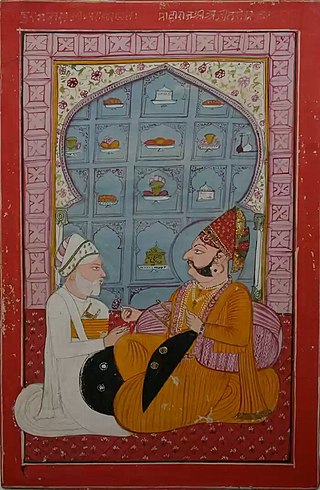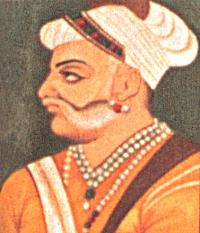
Marwar is a region of western Rajasthan state in North Western India. It lies partly in the Thar Desert. The word 'maru' is Sanskrit for desert. In Rajasthani languages, "wad" means a protected area. English translation of the word 'marwar' is the region protected by desert.

The Rathore or Rathor is an Indian Rajput dynasty belonging to the clan that has historically ruled over parts of Rajasthan, Gujarat and Madhya Pradesh.

Mandore is a suburb Historical town located 9 km north of Jodhpur city, in the Indian state of Rajasthan.

Durgadas Rathore was the Rathore Rajput General of the Kingdom of Marwar. He is credited with having preserved the rule of the Rathore dynasty over Marwar, India, following the death of Maharaja Jaswant Singh in the 17th century. In doing so he had to defy Aurangzeb, a Mughal emperor. He commanded the Rathore forces during the Rajput War (1679–1707) and played a major role in the Rajput Rebellion (1708–1710) which became one of the main reason of decline of Mughal Empire. He was elected as the leader of the revolt along with Raja Jai Singh II of Jaipur. He won a number of victories against the Mughals and forced many Mughal officers to pay tribute to him in the form of chauth.

Rao JodhaRathore was a Rajput chief of Rathore clan who ruled Mandore in the present-day state of Rajasthan. He was the son of Rao Ranmal. He is known for his illustrious military career and for founding the city of Jodhpur in 1459.

The region of Bikaner, stretching across northern Rajasthan State in India, was earlier known as Jangladesh. It included the present-day districts of Bikaner, Churu, Ganganagar, and Hanumangarh. It is bounded on the south by Marwar and Jaisalmer regions, on the east by Ajmer-Merwara region.
The Dalpat Vilas is the surviving fragment of a historical manuscript. Written in the Rajasthani language, it is the earliest known Charan source of Mughal-Rajput relations. The initial portion of the manuscript covers the genealogy of the Rathores and the Sur dynasty. The bulk of the manuscript chronicles events in Marwar and adjoining areas during the reign of Akbar.

Dingal, also known as Old Western Rajasthani, is an ancient Indian language written in Nagri script and having literature in prose as well as poetry. It is a language of very high tone and requires a specific style of speaking. Dingal was used in Rajasthan and adjoining areas including Gujarat, Kutch, Malwa, and Sindh. Most of Dingal literature is said to be composed by Charans. It was prominently used in composition of war poetry praising the martial exploits of Rajput and Charan war heroes.
Rajasthani literature is an tradition in Indian literature dating to the 2nd millennium, which includes literature written in the Rajasthani language. An early form of Rajasthani started developing in the 11th century from Saurseni Prakrit as Maru-Gurjar or Gurjar Apabhramsa. Early Rajasthani literature was usually written by Charans. Earlier Rajasthani was known as Charani or Dingal, which was close to Gujarati. Medieval Rajasthani literature was mostly heroic poetry mentioning the great kings and fighters of Rajasthan. Rabindra Nath Tagore, a Bengali polymath, once said, "The heroic sentiment which is the essence of every song and couplet of a Rajasthani is peculiar emotion of its own of which, however, the whole country may be proud". It is generally agreed that modern Rajasthani literature began with the works of Suryamal Misran, including the Vansa Bhaskara and the Vir Satsai. The Vansa Bhaskara contains accounts of the Rajput princes who ruled in what was then Rajputana, during the lifetime of the poet (1872–1952). The Vir Satsai is a collection of hundreds of couplets.

Kingdom of Marwar, also known as the Jodhpur State under the British, was a kingdom in the Marwar region from 1243 to 1818 and a princely state under British rule from 1818 to 1947. It was established in Pali by Rao Siha, possibly a migrant Gahadavala noble, in 1243. His successors continued to struggle against regional powers for domination and 9 out of 15 rulers till 1438 died in combat. In 1395, its capital was changed to Mandore by Rao Chunda of Mandore and to Jodhpur in 1459 by Rao Jodha.
Muhnot Nainsi (1610–1670) was a medieval historian and Dewan of Rathore ruler Jaswant Singh of Marwar. He is known for his studies of the region now encompassed by the state of Rajasthan in India. He was son of Jaimal Muhnot, who was Senior Office holder under reign of Sur Singh and Gaj Singh Early in his professional career, Nainsi was appointed successively as the hakim of various parganas in Marwar. The extensive, first-hand knowledge he collected of the region informed his later writings. In 1658, he was appointed dewan of Marwar, in which position he served until 1666. The literary works he is most known for are Marwar Ra Pargana Ri Vigat and Nainsi Ri Khyat.

Dursa Arha was a 16th-century warrior and Rajasthani (Dingal) poet from India. He earned the epithet of the 'First Nationalist Poet Of India' or Rashtrakavi because of his nationalist stance in his bold Dingal poems commending Maharana Pratap of Mewar in his struggle against the Mughal Empire. He is one of the most highly regarded poets of the time, who was also a valuable and respectable part of the Mughal court. He was a renowned litterateur, historian, war general, consultant, administrator, feudal lord, and magistrate. He had close relations with the rulers of many erstwhile kingdoms. On the basis of wealth, fame, and honor Dursa Arha acquired in his lifetime and his contribution to medieval Indian history and literature, the historians and litterateurs consider him as one of the greatest poets. Dursa Arha attained heights of opulence and grandeur reached by no other poet in history.

Abhai Singh Rathore was an 18th-century Indian Raja of the Kingdom of Marwar (Jodhpur).

Rao Ganga or Rav Gango Vaghavat was an Indian king from the Rathore dynasty who ruled the traditional Rathore realm of Maruwara (Marwar) in the present-day state of Rajasthan. Ganga ascended to the throne in 1515 through the support from his family nobles. During his reign, the Rathores consolidated and expanded their rule in Marwar.
Rao Ranmal, also called Ran Mal or Ridmal, was the Rathore ruler of Marwar. A notable expansionist and skilled warrior, Ranmal is also noteworthy for having twice served as regent of the kingdom of Mewar under two different kings.
Khyat is a form of bardic historical prose that was prevalent in the western Indian states of Rajasthan and Gujarat. It is a collection of events or continuous history. Khyats generally contained histories of a ruling dynasty or a person. In the former states that now constitute Rajasthan, Khyatas were written by the Charans under the patronage of rulers who wished to perpetuate their exploits. These accounts contained histories of battles, sacrifices, valour, and chivalry, values that came to be associated with Rajputs. Khyatas are often known by the name of their authors; e.g., Bankidās-ri-Khyāt. Nainsi-ri-Khyat written by Nainsi is considered to be the most prominent of khyats.
MahamahopadhyayaKaviraja MuraridanAshiya served as the Dewan of Marwar during the reign of Jaswant Singh II (1873–1895). Kaviraja is remembered as an astute politician and a farsighted administrator, who made significant contributions to the history of Marwar. He was a Tazimi sardar (noble) and a renowned scholar, known for his prominent works including Yaśavaṃta-Yaśo-Bhūṣaṇa and Tawarikh Marwar.
Deora or Devda, Devra is a clan of Rajputs. The Deora dynasty historically ruled over Bhinmal, Sirohi and Chandravati, India. Rao Deoraj was the progenitor of the Deora clan.
Dadhivadia is a clan of Charanas of Rajasthan. It is also used as a surname.










